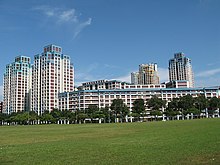
Back مسکن عمومی در سنگاپور Persian Logement social à Singapour French Rumah publik di Singapura ID 公営住宅 (シンガポール) Japanese Социальное жильё в Сингапуре Russian Соціальне житло в Сінгапурі Ukrainian 组屋 Chinese

Public housing in Singapore is subsidised, built, and managed by the Government of Singapore. Starting in the 1930s, the country's first public housing was built by the Singapore Improvement Trust (SIT) in a similar fashion to contemporaneous British public housing projects, and housing for the resettlement of squatters was built from the late 1950s. In the 1960s under the SIT's successor, the Housing and Development Board (HDB), public housing consisting of small units with basic amenities was constructed as quickly and cheaply as possible at high densities and used for resettlement schemes. From the late 1960s, housing programmes focused more on quality, public housing was built in new towns, and a scheme allowing residents to lease their flats was introduced. Throughout the 1970s and 1980s, more public housing options were provided for the middle class and efforts to increase community cohesion within housing estates were made. From the 1990s, the government began portraying public housing as an asset, introducing large-scale upgrading schemes and loosening regulations on the resale of public housing while additional housing programmes for the sandwich classes and elderly residents were introduced. Rising housing prices led to public housing being seen as an investment from the 2000s, and new technologies and eco-friendly features were incorporated into housing estates.
In the early 2020s, Singapore's public housing is located in new towns, in communities that are intended to be self-contained, with services nearby housing blocks, and is either owned by or rented to residents. Lessee-occupied public housing is sold on a 99-year lease and can be sold on the private resale market under certain restrictions. Rental housing consists of smaller units and is mainly meant for lower-income households. Housing grants are provided to lower-income applicants for flat purchases while flats with shorter leases and lease monetisation schemes have been implemented for elderly homeowners. Housing estates are managed and maintained by town Councils, and older housing estates are improved by the Housing and Development Board under the Estate Renewal Strategy.
As of 2020, 78.7% of Singapore residents live in public housing, down from a high of 88.0% in 2000.[1]
- ^ Department of Statistics, Ministry of Trade & Industry, Republic of Singapore (September 2021). "Population Trends, 2021, ISSN 2591-8028" (PDF). Singapore Department of Statistics. Archived (PDF) from the original on 19 January 2022. Retrieved 4 February 2022.
{{cite web}}: CS1 maint: multiple names: authors list (link)
© MMXXIII Rich X Search. We shall prevail. All rights reserved. Rich X Search